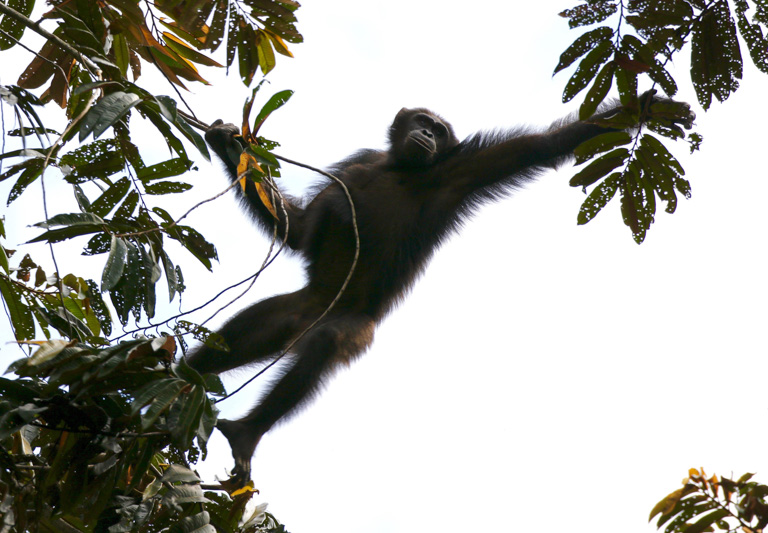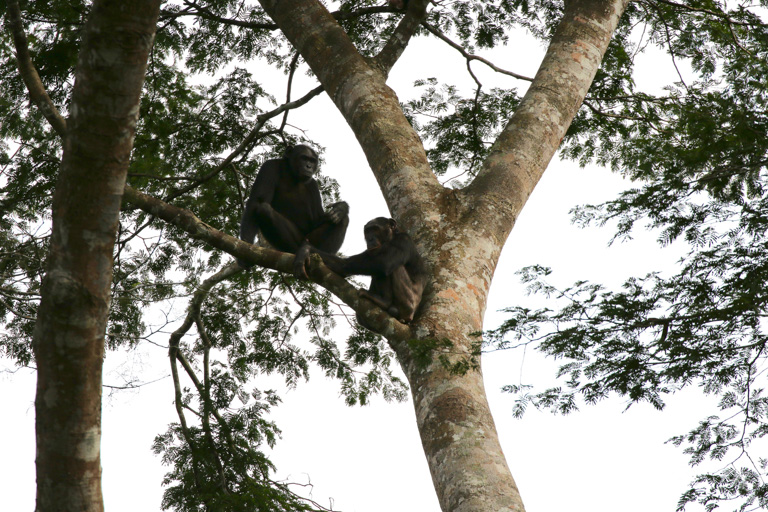- A study led by WCS researchers pulled together wildlife survey data collected between 2003 and 2013 at 59 sites in five countries across western Central Africa.
- They then developed mathematical models to understand where the highest densities of gorillas and chimpanzees are and why, as well as broader trends in the populations.
- They found that more than 361,000 western lowland gorillas (Gorilla gorilla gorilla) and almost 129,000 central chimpanzees (Pan troglodytes troglodytes) inhabit these forests — about 30 percent more gorillas and 10 percent more chimpanzees than previously estimated.
- The team’s analyses also demonstrate that western lowland gorilla numbers are slipping by 2.7 percent a year.
Leveraging the most comprehensive dataset ever compiled for the gorillas and chimpanzees that live in western Central Africa, scientists have concluded that there are more of the two subspecies than previously estimated, but that most of them also live outside the protected confines of parks and reserves.
“It’s great news that the forests of Western Equatorial Africa still contain hundreds of thousands of gorillas and chimpanzees, but we’re also concerned that so many of these primates are outside of protected areas and vulnerable to poachers, disease, and habitat degradation and loss,” conservation scientist Samantha Strindberg of the Wildlife Conservation Society (WCS) said in a statement.

Strindberg and co-lead author and WCS conservation scientist Fiona Maisels led a team of more than 50 researchers in pulling together wildlife survey data collected between 2003 and 2013 at 59 sites in five countries. Field researchers walked some 8,700 kilometers (5,400 miles) to gather the information used in the study, covering an area of 192,000 square kilometers (74,100 square miles) — larger than the country of Syria or the U.S. state of Washington.
They published their work on April 26 in the journal Science Advances.
They found that more than 361,000 western lowland gorillas (Gorilla gorilla gorilla) and almost 129,000 central chimpanzees (Pan troglodytes troglodytes) inhabit these forests. That’s more than 30 percent more gorillas and about 10 percent more chimpanzees than estimates from prior research.
“The boots on the ground research teams and partnerships are crucial to the success of these programs and the conservation of gorillas and chimpanzees,” said study co-author Dave Morgan, a biologist with the Lincoln Park Zoo who leads the Goualougo Triangle Ape Project in the northern Republic of Congo, in the statement from the WCS.
During these surveys, researchers also collected data on other animals they came across. In 2013, the journal PLOS ONE published similar data collected on forest elephants (Loxodonta cyclotis), with the startling conclusion that forest elephant numbers in Central Africa had gone down by more than 60 percent between 2002 and 2011. Maisels said members of the team also had plans to do a similar analysis on forest antelopes this year.

After compiling the data, the team built mathematical models to understand where the highest densities of gorillas and chimpanzees are and why, as well as broader trends in the populations.
The team’s analysis demonstrates that, despite the sheer number of western lowland gorillas living in the region, that figure is slipping by 2.7 percent a year. It’s further evidence that the IUCN should continue to list this subspecies of gorillas as critically endangered, or just a step away from being extinct in the wild.
The data did not indicate a similar slide in endangered chimpanzee numbers. But that doesn’t mean that a decline isn’t happening, Maisels said, only that their analysis didn’t pick up a significant trend.
“What is certain is that they have just as much difficulty as gorillas in recovering after a population decline,” Maisels told Mongabay. Like gorillas, chimpanzees are slow to mature and reproduce. That makes coming back from big losses an uphill climb for populations, whether the losses are the result of disease, habitat loss or illegal hunting — the three primary threats to the animals’ survival.
Prior research has shown that diseases, like the one caused by the Ebola virus, can decimate ape numbers by 90 percent in specific areas, Maisels said. Likewise, hunting remains a serious threat, even though international and national laws prohibit the killing of apes and other endangered animals.

“All great apes, whether in Africa or Asia, are threatened by poaching, especially for the bushmeat trade,” WWF primatologist and co-author David Greer said in the WCS statement.
But the study also showed that parks and timber concessions can reduce this threat substantially.
“Our study found that apes could live in safety, and thus in higher numbers, at guarded sites than if there was no protection,” Greer said.
Timber concessions can be the “next best thing” to protected areas, Maisels said, if they adhere to the standards set by the Forest Stewardship Council by only cutting a few trees per hectare, keeping hunters out, and closing down logging roads once they’re finished.
The northern Republic of Congo is home to tens of thousands of apes as well as a timber industry that serves as an economic engine for the country. Gorilla numbers stay fairly steady in “well-managed” logging concessions, Maisels said, as research by Dave Morgan and his colleagues in the journal Biological Conservation has recently shown.

That 80 percent of the region’s central chimpanzees and western lowland gorillas live outside protected areas makes good management of these concessions even more critical. Still, in an overarching strategy to protect these animals, “Protected areas are the core because they can be maintained with more confidence in the very long term than other types of concession,” Maisels said.
She explained that it’s much more difficult for authorities to turn a park into an agricultural plantation for bananas, oil palm or another crop than it is to convert a logging concession to those uses. The forest clearing necessary to establish these plantations devastate the habitats of apes and countless other species.
This study grew out of the IUCN’s action plan for western lowland gorillas and central chimpanzees put together in 2014, which lays out a series of steps to protect the subspecies at both local and regional levels. It demonstrates that a combination of strategies just might be enough to provide some hope for the region’s threatened apes, said Liz Williamson, a primatologist at the University of Stirling and a co-author of the paper.
“A combination of responsible industrial practices, conservation policies, and a network of well-managed parks and corridors would provide wildlife managers with a winning formula for conserving great apes in Central Africa,” Williamson said in the statement from the WCS. “Our study has revealed that it is not too late to secure a future for gorillas and chimpanzees.”
Banner image of western lowland gorilla infants by Terence Fuh Neba/WWF Central African Republic.
John Cannon is a staff writer at Mongabay. Find him on Twitter: @johnccannon
CITATIONS
Bermejo, M., Rodríguez-Teijeiro, J. D., Illera, G., Barroso, A., Vilà, C., & Walsh, P. D. (2006). Ebola outbreak killed 5000 gorillas. Science, 314(5805), 1564-1564.
Maisels, F., Strindberg, S., Blake, S., Wittemyer, G., Hart, J., Williamson, E. A., … & Bakabana, P. C. (2013). Devastating decline of forest elephants in Central Africa. PloS one, 8(3), e59469.
Morgan, D., Mundry, R., Sanz, C., Ayina, C. E., Strindberg, S., Lonsdorf, E., & Kühl, H. S. (2017). African apes coexisting with logging: Comparing chimpanzee (Pan troglodytes troglodytes) and gorilla (Gorilla gorilla gorilla) resource needs and responses to forestry activities. Biological Conservation.
Strindberg, S., Maisels, F., Williamson, E. A., Blake, S., Stokes, E. J., Aba’a, R., … Wilkie, D. S. (2018). Guns, germs, and trees determine density and distribution of gorillas and chimpanzees in Western Equatorial Africa. Science Advances, 4(4).
FEEDBACK: Use this form to send a message to the author of this post. If you want to post a public comment, you can do that at the bottom of the page.
